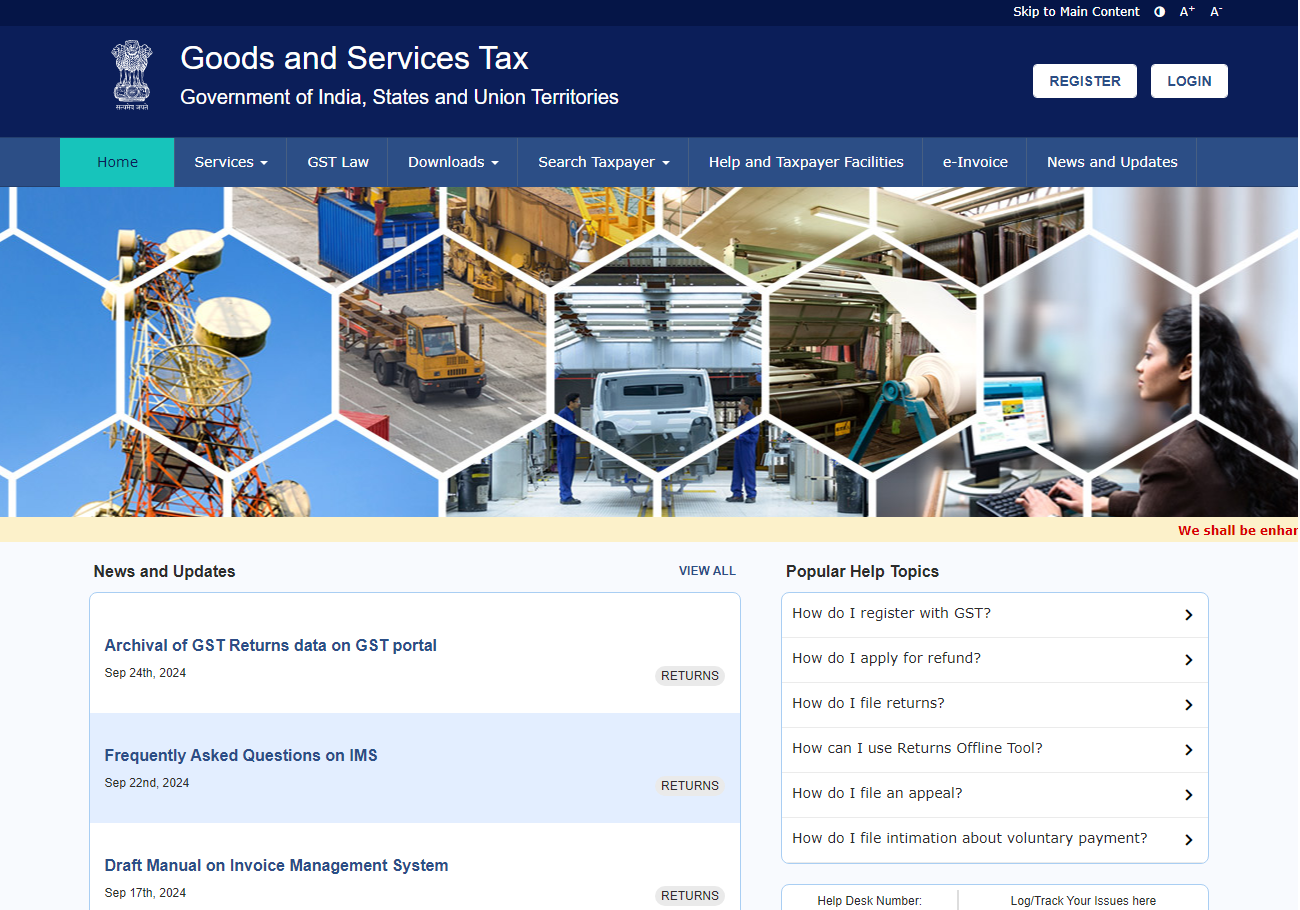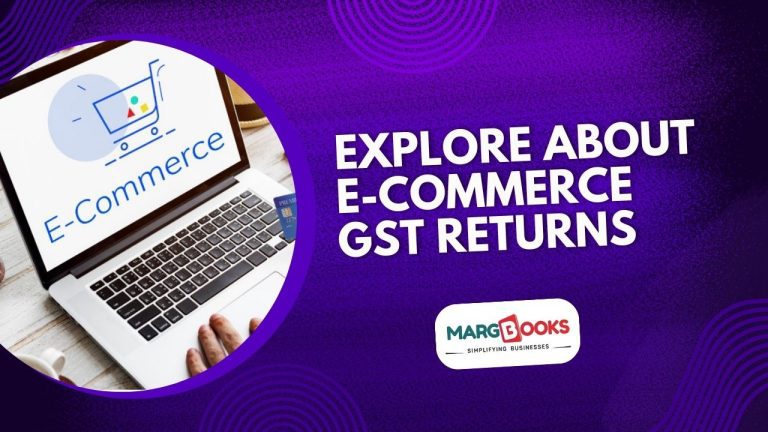E-commerce is growing fast, and with it comes the responsibility of following the right tax laws. In India, businesses need to deal with GST (Goods and Services Tax), which is a tax on the sale of goods and services. This includes e-commerce businesses. Filing GST returns is a must for online businesses to stay on the right side of the law. In this article, we will talk about what e-commerce GST returns are, why they matter, how to file them, and how e-commerce businesses can stay compliant with the rules.
What is an E-Commerce GST Return?
GST returns are documents that online businesses file with the government. These documents include details about sales, purchases, and taxes. Based on these returns, the government calculates the amount of GST that a business has to pay. For e-commerce businesses, GST return filing is crucial because it shows all the transactions they’ve made through their online platform.
In simple terms, an e-commerce GST return is the record of all financial activities of an online business. It includes details like sales, purchases, and the amount of GST that needs to be paid or claimed. Filing GST returns regularly is important because it helps businesses stay compliant with tax laws and avoid penalties.
Why Filing E-Commerce GST Returns is Important?
Filing e-commerce GST returns is necessary for several reasons:
- Stay Within the Law: GST is required for businesses with annual sales above a certain limit. If an e-commerce business doesn’t file GST returns, it may face legal troubles.
- Avoid Penalties: If an online business files its GST returns late or makes mistakes, it may have to pay penalties. Filing returns on time helps avoid these fines.
- Claim Input Tax Credit (ITC): GST returns allow businesses to claim back the GST they’ve paid on their purchases. This can lower the total tax they owe.
- Maintain Transparency: Filing returns keeps a business’s tax records clear and up to date. This helps in case there is any tax inspection or review.
- Build Trust: By regularly filing GST returns, e-commerce businesses build trust with their customers and suppliers. This can lead to better business relationships and reputation.
How Does GST Work for E-Commerce Businesses?
GST rules for e-commerce businesses differ slightly from other types of businesses. Since e-commerce deals with online transactions across many regions, there are special provisions for how GST is applied. Here’s how GST works for e-commerce:
- GST Registration: Any e-commerce business, no matter its size or sales, must register for GST. This is different from other businesses, which only need to register when they cross a certain sales threshold.
- Tax Collection at Source (TCS): E-commerce platforms must collect a small percentage (1%) as tax at source (TCS) on the sales made through their platform. This tax is later paid to the government.
- Filing GSTR-8: E-commerce operators are required to file a special return called GSTR-8. This form contains details of all the TCS collected from sellers and must be filed monthly.
- Reverse Charge Mechanism (RCM): In some cases, e-commerce businesses may need to pay GST under the reverse charge mechanism. This means that the buyer (e-commerce platform) must pay the GST instead of the seller.
- Multiple State Registrations: Since e-commerce businesses often sell goods across different states, they may need to register under GST in each state where they have customers. This can make compliance more complex.
Types of GST Returns for E-Commerce Businesses
Different types of GST returns must be filed by e-commerce businesses based on the role they play (whether they are operators or suppliers). The most common GST returns for e-commerce businesses are:
- GSTR-1 (Outward Supplies): This is a return that details all the sales made by the business. E-commerce businesses need to file this either monthly or quarterly. It lists the products sold, the tax collected, and other details.
- GSTR-3B (Monthly Summary): This is a summary return that businesses file every month. It includes a summary of sales, purchases, and the GST owed to the government after deducting input tax credits.
- GSTR-8 (TCS Filing): E-commerce operators file this return monthly. It contains details about the tax collected at source (TCS) from sellers on the platform.
- GSTR-9 (Annual Return): This is an annual return filed by e-commerce businesses. It sums up all the transactions and tax details from the entire year.
How to File E-Commerce GST Returns?

Filing GST returns for e-commerce businesses involves several steps. Here’s a simple guide:
-
Log in to the GST Portal:
Visit the GST website and log in using your username and password.
-
Choose the Right Return Form:
Depending on your business type, select the appropriate GST return form (GSTR-1, GSTR-3B, GSTR-8, etc.). Each form is meant for different purposes, so choose wisely.
-
Enter Transaction Details:
Fill in the details about your sales, purchases, taxes collected, and any input tax credits. Make sure all the details are accurate.
-
Submit the Return:
After entering all the details, review the form carefully and submit it online.
-
Pay the Tax Due:
After submitting the return, pay any GST that is due. The GST portal will guide you on how much tax you owe after applying any input tax credits.
-
Download the Acknowledgment:
Once the return is filed and the payment is made, download the acknowledgment for your records.
Common Problems Faced by E-Commerce Businesses in Filing GST Returns
Filing GST returns can be tricky for e-commerce businesses. Here are some common challenges they face:
- Multiple State Registrations: E-commerce businesses that sell across states may need to register in each state, which adds complexity to the filing process.
- Tracking TCS: E-commerce operators must collect tax at source (TCS) and report it every month. Keeping track of these numbers can be tough.
- Data Reconciliation: The data in GSTR-1, GSTR-3B, and GSTR-8 must match. If the numbers don’t add up, it can cause issues with the tax department.
- Frequent GST Rule Changes: GST laws change often, and staying updated can be challenging for small businesses. It’s important to stay informed about any changes that may affect how returns are filed.
- Technical Issues: The GST portal can sometimes have technical issues, especially during peak filing periods. This can cause delays and add stress to the process.
Tips to Make Filing E-Commerce GST Returns Easier
Here are some tips to help e-commerce businesses file their GST returns smoothly:
- Use GST Software: Consider using automated GST software. It can calculate taxes, generate invoices, and make filing returns faster and easier.
- Keep Records Organized: Make sure you have proper records of all your transactions, including sales, purchases, and TCS collected. Having organized records will save time when filing returns.
- Hire a Professional Accountant: If the process seems complicated, you can hire an accountant who is experienced with GST returns. They can help you file the returns accurately and on time.
- Stay Updated on GST Laws: Follow news about any changes to GST rules and regulations that may affect your business. This will ensure you stay compliant and avoid any penalties.
- File on Time: Always file your returns before the deadline to avoid late fees and penalties. Set reminders so you don’t miss any important dates.
Conclusion
In conclusion, understanding and filing e-commerce GST returns is essential for all online businesses. It helps businesses remain compliant with the law, avoid penalties, and take advantage of tax credits. While the process may seem complicated at first, using the right tools, maintaining accurate records, and staying informed about GST rules can make it easier. By filing GST returns regularly, e-commerce businesses can ensure smooth operations and focus on growing their business.
Also Read
- What Details Must be Included in a Sale Bill with GST?Getting your GST paperwork wrong feels like walking through a minefield, doesn’t it? One missing detail on your invoices, and suddenly you’re dealing with compliance headaches that could’ve been easily avoided. Creating a proper Sale Bill with GST isn’t rocket… Read more: What Details Must be Included in a Sale Bill with GST?
- How Is a Purchase Bill with GST Different from a Sales Invoice?Running a business in today’s GST-enabled economy requires more than just selling and buying. It’s about being organised, compliant, and aware of what each document in your billing system stands for. One common confusion many businesses face is the difference… Read more: How Is a Purchase Bill with GST Different from a Sales Invoice?
- How Can You Generate a Mobile GST Bill in Seconds?Running a shop is hard enough. But when billing takes forever and GST compliance gets messy, things can slow down. That’s where a Mobile GST Bill comes to the rescue. Whether you run a busy garment store or a local… Read more: How Can You Generate a Mobile GST Bill in Seconds?
- What Happens If GST on Advance Received Is Not Paid on Time?Running a business in India requires keeping pace with ever-evolving tax laws, and GST in advance is one such area that many businesses often overlook sometimes unintentionally. But missing out on timely GST payment on advances can lead to unnecessary… Read more: What Happens If GST on Advance Received Is Not Paid on Time?
- How Does the 9988 HSN Code Impact GST Filing for Businesses?Navigating the complexities of GST can be daunting, especially for service-based businesses in India. Among the many elements of GST compliance, the HSN (Harmonised System of Nomenclature) code plays a crucial role in categorising goods and services. One such classification… Read more: How Does the 9988 HSN Code Impact GST Filing for Businesses?
Frequently Asked Question
What is an e-commerce GST return?
An e-commerce GST return is a document filed by online businesses that details sales, purchases, and the amount of tax to be paid or claimed. It includes all the transactions done through an e-commerce platform, helping the government track tax liabilities and collections.
Why is filing GST returns important for e-commerce?
Filing GST returns is mandatory to comply with tax laws, avoid penalties, and claim Input Tax Credit (ITC). It keeps your business records transparent and helps you maintain trust with customers and suppliers. Missing GST returns can lead to legal problems.
Which GST returns do e-commerce businesses need to file?
E-commerce businesses file various GST returns, including GSTR-1 (sales), GSTR-3B (monthly summary), GSTR-8 (TCS details), and GSTR-9 (annual return). These forms capture different aspects of business transactions and tax payments.
What is Tax Collected at Source (TCS) in GST?
Tax Collected at Source (TCS) is a small percentage of tax collected by e-commerce operators from sellers on their platform. This tax is reported in GSTR-8 and must be paid to the government. TCS applies to all e-commerce sales.
How does GST differ for e-commerce businesses?
GST rules for e-commerce businesses include mandatory registration, TCS collection, and the need for multiple state registrations. E-commerce businesses face special provisions due to their online nature and the wide geographical reach of their transactions.
Can e-commerce businesses claim Input Tax Credit (ITC)?
Yes, e-commerce businesses can claim Input Tax Credit (ITC) on the GST they pay for purchases and services. ITC reduces the overall GST liability by allowing businesses to offset their tax payments against taxes already paid on purchases.
How often do e-commerce businesses need to file GST returns?
E-commerce businesses usually file GST returns monthly. Forms like GSTR-1 and GSTR-3B must be submitted every month, while GSTR-8 (TCS) is also filed monthly. The annual return (GSTR-9) must be filed once a year.
What happens if an e-commerce business doesn’t file GST?
If an e-commerce business fails to file GST returns, it may face fines, penalties, and legal action. Non-compliance can also result in the loss of Input Tax Credit and create issues during tax audits or reviews.
Is GST registration mandatory for all e-commerce businesses?
Yes, GST registration is mandatory for all e-commerce businesses, regardless of their turnover. Unlike other businesses, there is no exemption based on annual sales. E-commerce businesses must register as soon as they start selling online.
How can e-commerce businesses simplify GST return filing?
E-commerce businesses can simplify GST return filing by using GST software, keeping accurate records, hiring an accountant, and staying updated on GST law changes. Filing returns on time and ensuring accuracy also helps avoid complications.






